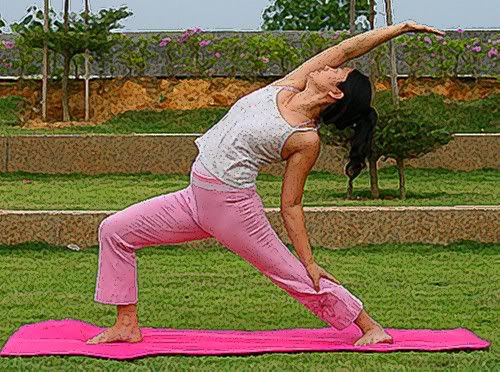
This post somehow completed the warrior version of asana. Remember when I posted the pose on Warrior I, II & III? From Warrior II place the rear hand down the back of your tight. I would prefer to bend my arm a bit for back support. You should feel the stretches on your side oblique and lateral muscle. Practise this asana in a slow and graceful manners. I always feel like I’m swaying.
Namaste, everyone!
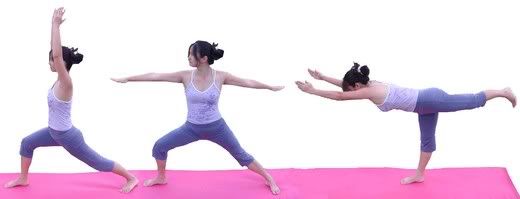
Sanskrit: Virabhadrasana I, II & III
Warrior pose is named after a mystic sage called Virabhadra. This pose help strengthen the legs and back muscle at the same time opens the chest and shoulder while toning the abdominal muscle.
Whenever I am in this pose (warrior I & II), I will never forget to check out my toes. Yea, you should bend your knee at 90 degree (only!) and should be able to see all your 5 toes. Oh, and also not forgetting, “TUCK IN YOUR TAILBONE!!!” There you go. So many reminders. lol.
Namaste, everyone!
Sanskrit:Â Prapadasana

Tiptoe pose is a challenging balance pose that develop and strengthens your knees and ankles. It also promotes overall balance, stability and confidence.
For beginner, you may squat down and bring one leg up onto your tight. Find a balancing point. To come out from the pose, simply uncross your leg and sit down before stretching your leg out.
For intermediate practitioner, you may start standing tiptoe in Tree pose by placing the foot on your tight instead of inner tight and come down to the floor in a forward bending. Squating down still on tiptoe. Find a focus point and once your body stabilized, place your palm in prayer pose. To come out from the post, lift your body up making sure you are still tiptoeing. Release leg onto the floor.
Namaste, everyone!
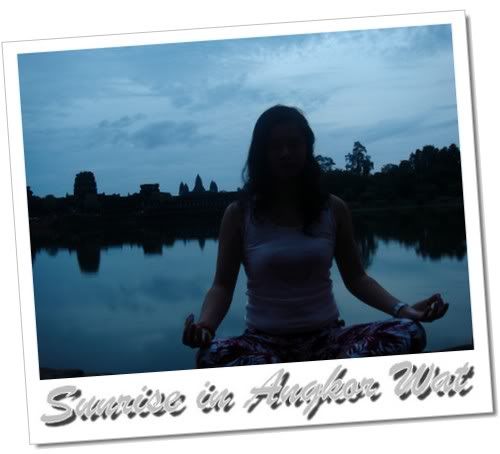
Before I left for Siem Reap, Cambodia, I told myself that I’m going to take lots of silly pictures of me in various Yoga Posture. Sad to say, I’ve disappointed myself with only a small number of silly-me-pictures. One of the main reason is my blocked mind. Other than the famous Lotus Pose and Tree Pose, my mind goes totally blank.
Enjoy, Namaste!
Sanskrit: Vasisthasana
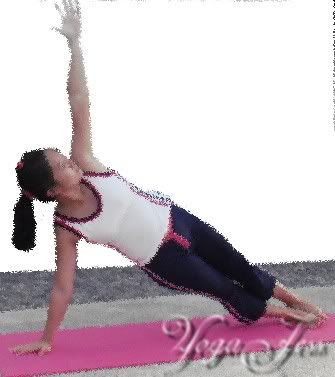
Lately I think my Pilates instructor a bit tau hong (crazy). I think he’s trying to kill us. In side plank, he make us reach out touching our toes for 8 times. I just touch my knee. Boh lat (no energy). He came over to me and whisper, “touch your toes!” Blueh…
Not only he kept us out of breath, last week, after all the panting and sweating, he concluded the class by saying, “today don’t have savasana.” OMG, I just wanna die.
This post is by special request of a fellow friend of mine. The differences of Pyramid and Traditional headstand.
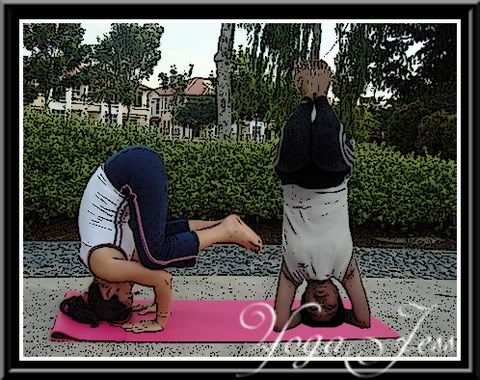 Left: Traditional Headstand. Right: Pyramid Headstand
Left: Traditional Headstand. Right: Pyramid Headstand
And yes! During the photoshoot, I fell backward to the ground numerous times. Surprisingly, I felt myself like a feather. Gently falling down, gliding my butt on the mat, lastly my legs touching the ground instead of falling down like a log *TIMBER!*. Nothing breaks except for a sore neck the next day.
All well, ends well. Namaste, everyone!
Sanskrit:Â Vrikshasana
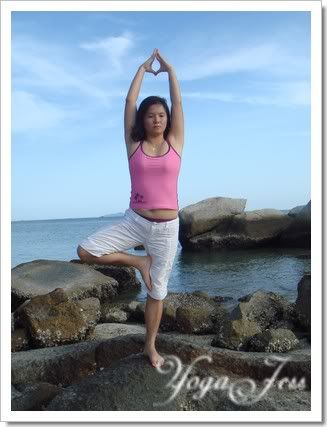
Imagine you are a tree. Your foot is the root and your leg is the trunk. Continue imagining your outstretched arm and head is the branches and leaves. You maybe unsteady for a while and your body swaying back and forth and your leg go wobbly like a tree bending in the wind yet staying upright and keep concentrating at one point. Yes, our body can maintain the balancing on one foot.
For a challenge, turn your head looking to your left while maintaining your posture firmly. Repeat on the right side. I find that it’s a big challenge as our body balances on one straight point and thus loosing balances the moment we turn our head.
Sanskrit : Garudasana

The Eagle Posture will strengthen your legs, knees and ankles. It stretches and tones muscles of the leg that grow weak from sedentary lifestyles ad can help relieve cramps of the legs. However, if you have knee pain, avoid doing this pose.
I do have problem with this posture. Blame it on my fat tight. I can’t seem to wrap my right foot all the way to the back. Each time I tried to do that, I will lost my balance. Now I just rest my fat tight on my left leg occasionally cheated by resting my toes on the floor for support. *ngek, ngek, ngek*
This is how you do it:
Draw the right foot upward bending the knee and wrap the right foot around your left leg as you rest the back of your right thigh on the left thigh. Cross your arms at the elbows, right over left. Join the palms of your hands together keeping the fingers pointed upward.
For a challenge, sink your hip lower and stretch your arms higher.
Namaste, everyone!
Different hand variation in Padmasana Posture.
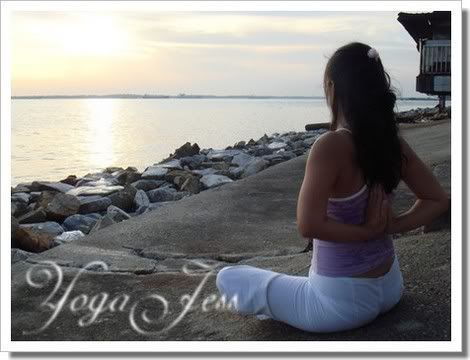
Backwards prayer position.
Take a deep breath, lengthen your spin, arch your back and stretch your hand backwards into prayer position. Exhale….. I need to perfect this posture by bringing up my hands higher tho. Maybe the next photoshoot 😉
Quick go learn this posture. Very useful if you are in Thailand. Like Kennysia said, “can greet sawadeeka from the back”.
Namaste, everyone.
Sanskrit name: Chakrasana aka urdhva-dhanurasana.
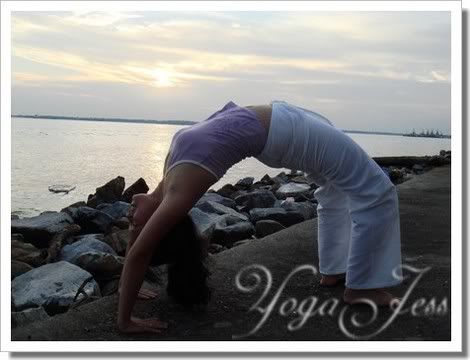
Chakra (cak – to move) means wheel and therefore this is the Wheel Posture. Urdhva means raised, elevated or upright and dhanur means bow. Both “wheel posture” and “upward bow posture” describe the appearance of this asana.
The first time I did this pose, I was not paying attention at the instructor. Hence, I failed to do it. During my second lesson under a different instructor, she explained to us in more details. Follow the step-by-step S.L.OW.L.Y and remember to breath.
- Lie flat on the back in the shavasana posture.
- While exhaling, bend the knees and bring the feet as close to the buttocks as possible with the soles of the feet on the floor.
- Bend the arms at the elbows and place the palms of the hands flat on the floor directly under each shoulder with the fingers pointing toward the back.
- While inhaling slowly, raise your head and rest your crown on the floor. I find that this is very helpful before pushing my hands, back and lastly, the buttocks off the floor while arching the spine.
I personally feel that grading for difficulty level lies solely on individual. Altho Chakrasana is graded at 8 out of 10, I might grade them 3 in my personal record.
Namaste, everyone!
